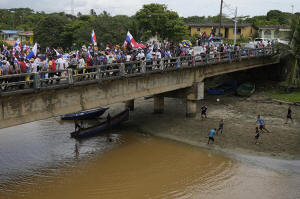|
The Panama Canal Authority (ACP) says building the reservoir is
the best way to provide an additional water source for over 2
million people in Panama City and to ensure the canal operates
efficiently in the coming decades.
The canal, which needs around 189 million liters (50 million
gallons) of freshwater for each ship crossing, faced severe
water shortages in 2023 due to lack of rain, forcing authorities
to cut crossings by 20% and delay traffic. The proposed
reservoir, which would take four years and $1.6 billion to
build, could allow 12 to 13 more ship crossings per day and
support new water treatment facilities being built, authorities
say.
But protesters say building the reservoir using the Indio River,
in the canal's watershed, would also force 2,000 people to be
relocated from their homes because their communities would be
flooded. Other areas downstream could also be affected by
reduced river flow.
Iris Gallardo, a teacher from the Guasimo community and a member
of the “No to Reservoirs” movement, was among the group of
mostly farmers waving Panamanian flags. She told the Associated
Press they held the boat protest to show their rejection of the
project and forced relocations.
“We are demanding that the multipurpose reservoir proposed by
the ACP not be built without consulting and getting permission
from the affected communities,” Gallardo said.
Instead, protestors suggest using the nearby Bayano Lake,
located east of the capital. Authorities dismissed that idea due
to logistical, legal challenges and cost, and said that such a
project would displace 200,000 people – far more than the
current plan. They said the project would also offer jobs to
communities and that the resettlement plan is being developed
with the community.
Former Panama Canal administrator Jorge Luis Quijano said
opponents of the project don’t understand how serious the water
problem is.
“The only way to have water is to store it,” he said.
All contents © copyright 2025 Associated Press. All rights
reserved |
|




